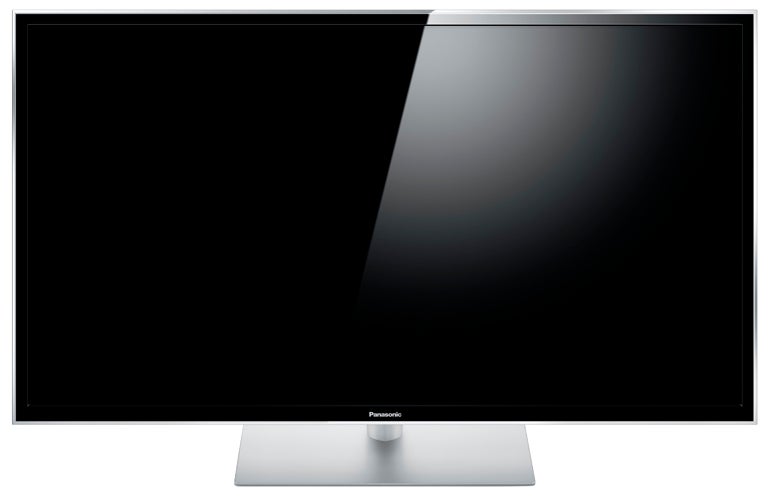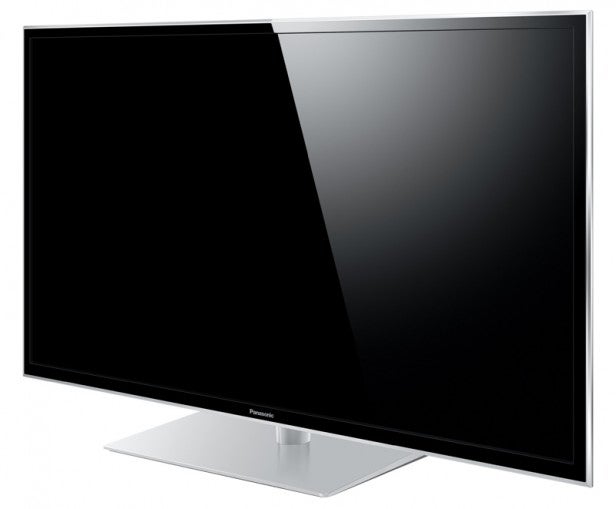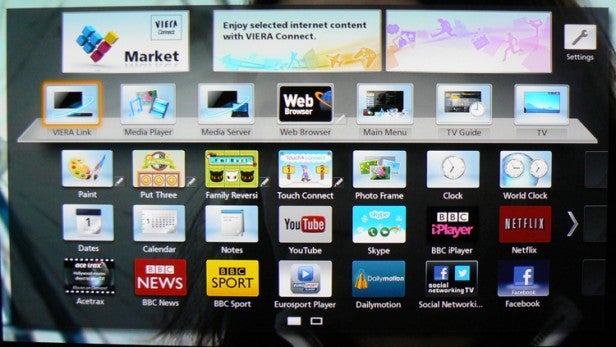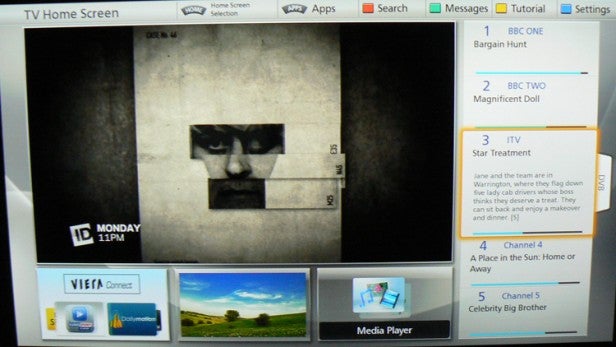Panasonic TX-P42ST60 Review
Panasonic TX-P42ST60
Can Panasonic still deliver plasma class at a cheaper price point?

Sections
- Page 1 Panasonic TX-P42ST60 Review
- Page 2 Picture Quality Review
- Page 3 3D, Audio and Conclusions Review
Verdict
Pros
- Stunning black level response
- Good value
- Excellent Smart TV interface
Cons
- Picture quality reduced by high levels of ambient light
- Surprisingly high input lag
- 3D motion judder
Key Specifications
- Review Price: £750.00
- 42-inch plasma TV
What is the Panasonic TX-P42ST60?
The 42-inch Panasonic P42ST60 basically represents your most affordable way of getting your hands on Panasonic’s latest plasma TV technology and Smart TV system. The brand’s cheaper X60 series use much lower grade panel designs than the ST60s and don’t offer any smart features, so while they’re certainly not to be discounted as a budget option, the P42ST60 is by far the more exciting option. This is the smallest size in the range that’s also available as a 50-inch or 55-inch.

Panasonic TX-P42ST60 – Design and Features
The Panasonic TX-P42ST60 is rather less glamorous in its looks than Panasonic’s 2013 LCD TVs. The mostly black frame is quite wide by modern flat TV standards, and although an effort has been made to soften its impact by wrapping a sliver of silver around its outer edge, you can’t deny that the design feels a bit dated by today’s super-skinny standards.
Connectivity is solid. Multimedia playback is supported by a USB slot, an SD card slot, and both LAN and integrated Wi-Fi network options. Where video is concerned, it’s a touch disappointing to find only three HDMIs when most TVs these days manage four. But this limitation is more tolerable on a mid-range set like the Panasonic P42ST60 than it is on Panasonic’s high-end 2013 plasma models.
The P42ST60 can be wall mounted if you don’t want to set it onto its plinth stand, and wall mounting is assisted by the way the P42ST60’s connections are positioned for access from the side rather than facing straight out.
Rummaging through the P42ST60’s box we make an unwelcome discovery: one of Panasonic’s Electronic Touch Pens, with which you can interact directly with the P42ST60 by pressing, drawing or writing on its screen. Well, maybe it’s going too far to describe the Touch Pen as unwelcome; you do, after all, seem to be getting it more or less for free. But if there’s a more pointless feature on any TV this year we can’t think of it.
Looking for more useful features, the P42ST60 is a 3D-capable model, using the active (rather than passive) approach plasma TVs always have to use. It’s also got a real bounty of picture calibration options, including two noise reduction systems, multiple power levels for Panasonic’s Intelligent Frame Creation motion compensation processing, an adaptive gamma control sliding scale, three settings for the panel’s core luminance setting, and even full white balance, colour management and gamma controls.
The P42ST60’s panel, meanwhile, enjoys both a high-contrast filter and Panasonic’s Infinite Black Pro contrast technology.
However, it’s important to stress that the P42ST60 only houses at its heart a Panasonic NeoPlasma screen (and ‘2500Hz’ field driving tech), not one of the premium NeoPlasma Black 3000 panels that kick in with the Panasonic P42GT60 level of the brand’s latest plasma range. This may leave motion and brightness/vibrancy a little compromised on the ST60, while its colour handling only delivers a claimed 12,288 colour gradation steps versus 24,576 on the P42GT60. This latter point means we’ll have to be on the look out for more colour banding and less colour ‘resolution’ in its pictures.
The P42ST60 also lacks versus its GT60 sibling: 1080 Pure Direct enhanced Blu-ray mode (though there is a reasonably successful 1080p Pixel Direct setting instead); THX certification; ISF endorsement; and Hexa picture processing engine.
Add up all the omissions from the P42ST60’s spec versus the GT60 models and there are genuine reasons to start worrying about the P42ST60’s potential appeal. But before these worries become overwhelming, it’s worth noting that at £750, the P42ST60 is around £200 cheaper than its GT60 equivalent. So while it’s looking likely that the P42ST60 won’t deliver a performance as good as that of the P42GT60, it could still deliver more than enough picture quality to make it great value.

Panasonic TX-P42ST60: Smart TV
The amount of photo, video and music file formats supported by the P42ST60’s multimedia connections is extensive, while the network connections also, of course, provide access to Panasonic’s latest online system.
Dubbed Viera Connect, the online platform scores well for its presentation and navigational aids, as well as the apparent robustness and stability of its infrastructure. However, it suffers for not having nearly as many of the key UK video streaming platforms as some of its rivals. So while you get Netflix, the BBC iPlayer, YouTube and the BBC News and Sport streaming feeds, there’s no LoveFilm, no ITV Player, no 4OD, and no Demand 5. Samsung, by comparison, offers ALL of these services on its Smart TV platform.
Panasonic does have a couple of smart TV aces up its sleeve, though, in the form of its My Home Screen interface and its impressively comprehensive iOS and Android control apps. These apps support screen sharing to and from the TV, and include all their functionality within a single app, rather than forcing you to use two or three separate apps as Samsung’s smart TVs do.
We’ll cover My Home Screen and the apps more in the Set Up section of this review, but we’ve also covered them in depth in a dedicated Panasonic Smart TV review.

Panasonic TX-P42ST60: Set Up
Panasonic has worked really hard to make its TVs more user friendly this year – a fact that becomes abundantly apparent as soon as you switch it on and are greeted by some of the most friendly, straightforward but also comprehensive set up guidance we’ve ever seen on a TV.
This early positive impression is taken to a whole other level, moreover, once you’re introduced to Panasonic’s My Home Screen interface for organizing and accessing the myriad content sources the P42ST60 can marshal. This multi-hub interface provides TV, lifestyle and info pages as standard, but even better it lets you set up your own hub screens, personalized to show links to only the sort of content and apps you most regularly like to watch/use. With a clean layout and plenty of onscreen navigation points and readily available onscreen help the P42ST60 makes getting to grips with the modern world of multiple content streams child’s play.
The way you can share content between your TV and your smart devices simply by swiping your fingers across your smart device’s screen in the relevant direction is a stroke of user-friendly genius too.
Things aren’t quite as friendly when it comes to calibrating the P42ST60’s pictures, though. The menus for this look a bit dour after the attractiveness of the My Home Screen stuff, and the organization is rather tortuous and overwhelming in places.
You need to be a bit more careful with the picture settings you use with the P42ST60 than you do with the more forgiving P42GT60, too. For instance, we’d suggest leaving all noise reduction systems off when watching HD if you don’t want images to start looking a bit soft, and that you use the 24p Smooth Film option set to its Min level (rather than off) when watching Blu-rays if you don’t want pictures to look a bit jerky and fizzy.
And whatever else you do, avoid the Dynamic preset and turn off the Ambient sensor if you know what’s good for you (though this advice applies to any Panasonic plasma set, actually).
How we test televisions
We test every TV we review thoroughly over an extended period of time. We use industry standard tests to compare features properly. We’ll always tell you what we find. We never, ever, accept money to review a product.

